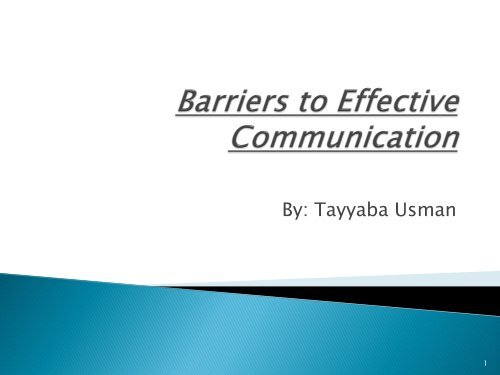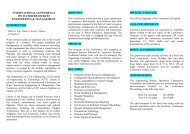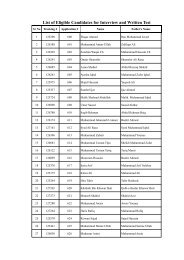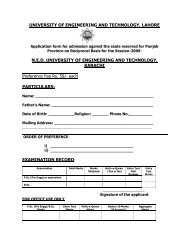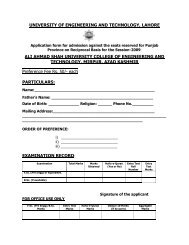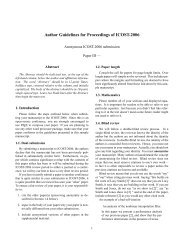Barriers to Effective Communication
Barriers to Effective Communication
Barriers to Effective Communication
You also want an ePaper? Increase the reach of your titles
YUMPU automatically turns print PDFs into web optimized ePapers that Google loves.
By: Tayyaba Usman<br />
1
"A barrier <strong>to</strong> communication is something that<br />
keeps meanings from meeting. Meaning barriers<br />
exist between all people, making communication<br />
much more difficult than most people seem <strong>to</strong><br />
realize. It is false <strong>to</strong> assume that if one can talk<br />
he can communicate. Because so much of our<br />
education misleads people in<strong>to</strong> thinking that<br />
communication is easier than it is, they become<br />
discouraged and give up when they run in<strong>to</strong><br />
difficulty. Because they do not understand the<br />
nature of the problem, they do not know what <strong>to</strong><br />
do. The wonder is not that communicating is as<br />
difficult as it is, but that it occurs as much as it<br />
does."<br />
2
When people are under stress, they are more<br />
apt <strong>to</strong> inject communication barriers in<strong>to</strong><br />
their conversation. These barriers can exist in<br />
any of the three components of<br />
communication (verbal, paraverbal, and<br />
nonverbal).<br />
3
.According <strong>to</strong> Thomas Gordon, author of the<br />
Parent <strong>Effective</strong>ness Training program, people<br />
use communication barriers 90% of the time<br />
in conflict situations. For this reason, it is<br />
worthwhile <strong>to</strong> describe some of the common<br />
responses that will, inevitably, have a<br />
negative effect on communications:<br />
4
1. Attacking (interrogating, criticizing,<br />
blaming, shaming)<br />
5
"If you were doing your job and supervising<br />
Susie in the lunch line we probably wouldn't<br />
be in this situation, would we?"<br />
"Have you followed through with the<br />
counseling we asked you <strong>to</strong> do? Have you<br />
gotten Ben <strong>to</strong> the doc<strong>to</strong>r's for his medical<br />
checkup? Did you call and arrange for a Big<br />
Brother? Have you found out if you're eligible<br />
for food stamps?"<br />
6
"From what I can see, you don't have the<br />
training <strong>to</strong> teach a child with ADHD.<br />
Obviously if you did you would be using<br />
different strategies that wouldn't make her<br />
feel like she's a bad person."<br />
7
"You don't seem <strong>to</strong> understand how<br />
important it is for your child <strong>to</strong> get this help.<br />
Don't you see that he's well on his way <strong>to</strong><br />
becoming a sociopath?“<br />
"You obviously don't realize that if you were<br />
following the same steps we do at home you<br />
wouldn't be having this problem. You don't<br />
seem <strong>to</strong> care about what ís going on in this<br />
child's life outside of school."<br />
8
"If you don't voluntarily agree <strong>to</strong> this<br />
evaluation we can take you <strong>to</strong> due process.<br />
Go ahead and file a complaint if you want <strong>to</strong>.“<br />
"I'm going <strong>to</strong> write a letter of complaint <strong>to</strong> the<br />
superintendent and have this in your file if<br />
you don't s<strong>to</strong>p humiliating my son in front of<br />
his classmates. I know my rights."<br />
9
4. Other Verbal <strong>Barriers</strong>: shouting, name<br />
calling, refusing <strong>to</strong> speak.<br />
10
1. Flashing or rolling eyes<br />
2. Quick or slow movements.<br />
3. Arms crossed, legs crossed<br />
4. Gestures made with exasperation<br />
5. Slouching, hunching over<br />
6. Poor personal care<br />
7. Doodling<br />
8. Staring at people or avoiding eye contact<br />
9. Excessive fidgeting with materials<br />
11
All of these examples of barriers<br />
thwart communication, mutual<br />
understanding, respect, problem<br />
solving, and identifying solutions that<br />
will meet everyone's needs. They put a<br />
serious strain on relationships that<br />
ultimately need <strong>to</strong> be collaborative in<br />
order <strong>to</strong> most effectively meet the<br />
needs of our children. Use of these<br />
"communication errors" results in<br />
increased emotional distancing<br />
between the parties, escalation in the<br />
intensity of the conflict and a negative<br />
environment for everyone involved.<br />
12
It is two way.<br />
It involves active listening.<br />
It reflects the accountability of speaker and<br />
listener.<br />
It utilizes feedback.<br />
It is free of stress.<br />
It is clear.<br />
13


